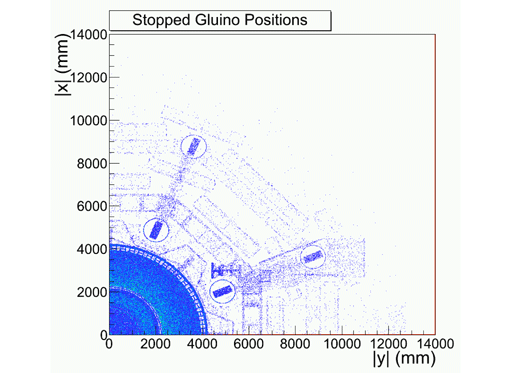
ATLAS e-News
23 February 2011
The search for stopped gluinos
22 September 2010

Simulated stopping positions of gluino R-hadrons within ATLAS.
While most ATLAS physics analyses entail picking apart collision events and looking for the characteristic signatures of items of interest, a small team from SLAC has other ideas. The signal they're seeking is that of a ‘stopped gluino’, and the best place to find evidence of it, they say, is not amongst the clamour of collisions but in the relative peace of empty bunch crossings.
Over the summer, the group used early ATLAS data to investigate the search backgrounds for these mysterious particles, and performed their own simulations to perfect methods for honing in on them, should they exist. Their findings were presented at ICHEP in Paris and SUSY10 in Bonn.
The gluino, supersymmetric partner to the gluon, features in all SUSY extensions to the Standard Model. Theory on the lifetime of this postulated particle varies, but the SLAC team are on the trail of a long-lived version; one which would be stable enough to travel the length of the detector before decaying. That is, unless it was stopped en route…
“The way [the gluino] interacts means that it can become charged – so it loses energy through ionisation as it passes through the detector,” explains Paul Jackson. “What can happen is it can lose all of its energy, run out of steam, and basically get caught in the detector.”
Theory predicts this to happen in about 10 per cent of cases, after which point the stopped gluinos will sit trapped in the detector until they decay, anywhere from seconds to years later, as dictated by their intrinsic lifetime.
Such gluinos are most likely to stop in the dense calorimeter, and will need to have masses well above 200 GeV (beyond current limits) for ATLAS to be able to measure their decays. Mechanisms of decay involve quarks or gluons and neutralinos, the Lightest Supersymmetric Particle (and a dark matter candidate), and manifest themselves as a whole lot of energy in the calorimeter, says Paul: “We're basically looking for one big fat jet.”
But picking out this big fat jet above the hubbub of collision events is about as easy as listening in on one conversation in a packed hall of chatterboxes. To know for certain that observed jets are due to a delayed decay and not a concurrent collision event, it's the quiet bunch crossings – those which don't contain any protons – that need to be studied.
These aren't silent themselves, of course. Constant cosmic events, detector noise, and beam backgrounds make the challenge in this case something akin to picking out a hushed conversation in a room with a loud refrigerator hum. But it's a start.
Understanding these remaining backgrounds will be key to spotting stopped gluino decays, if and when they occur. The SLAC group found that empty bunch data from 2010 is consistent with 2009 cosmic data, indicating that the majority of empty bunch events can be attributed to cosmic muons. By discounting tracks with hits in the muon system they managed to cut the cosmic background by about three orders of magnitude, and by applying shape, energy, and position criteria to the reconstructed jets they were finally left with a millionth of the original number of events.
Continuing the analogy, the chances of deciphering the aforementioned conversation suddenly seem a lot more promising, but this assumes a conversation is even taking place. In terms of actually seeing decaying gluinos, well, they must necessarily have been produced in the first place.
“There are competing factors,” explains Paul. Although the current abundance of empty bunches is great for the analysis, higher intensity in the machine would mean increased production of gluinos, assuming they are as heavy as speculated. “As we go to more filled bunches, that will obviously reduce the window where we can look, but we'll also have more intense beams so in principle we could produce more [gluinos].”
Simulating the gluino signal is “non-trivial”, and must be done in two stages. The first stage looks at gluino production, and makes a note of which particles stop and precisely where. With the duration of the intervening delay unknown, the second stage jumps ahead to the moment of decay, placing particles at the previously mapped stop positions before immediately decaying them in the simulation.
So far, this has only been done with private simulations, but it should soon be incorporated into the official ATLAS simulation software, along with luminosity and 'livetime' information from the detector. This is another non-standard feature of the analysis: the main background – cosmics – is constant, and won't scale with integrated luminosity. Instead, what will be important will be knowing precisely how many seconds of empty bunches have been recorded. “In a sense, that gives us our sensitivity to both the background and the signal,” says Paul.
Of course, if long-lived gluinos do exist, then the big question will be how long is 'long'? Extrapolating backwards to decipher the lifetime of the particle would be technically possible, according to Paul, but right now would constitute “trying to run before you can walk”.
“If we measure an anomalous signal, it's really interesting,” he adds, “but it's obviously going to be very challenging to make sure that it's not just some background that we haven't understood.”
 Ceri PerkinsATLAS e-News
|